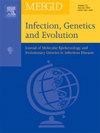诺氏疟原虫和间日疟原虫etram11.2基因遗传多样性和自然选择的计算机比较分析。
IF 2.6
4区 医学
Q3 INFECTIOUS DISEASES
引用次数: 0
摘要
对实地样本的遗传多样性进行全面分析对于开发有效的跨株疟疾疫苗至关重要,而能够产生交叉保护免疫的抗原对于防治疟疾至关重要。我们研究了etramp11.2的遗传多样性、自然选择、表位预测和单倍型网络分析。etramp11.2是最近在诺氏疟原虫和间日疟原虫临床样本中显示出跨种反应性的一种潜在抗原。从公共数据库中检索诺氏疟原虫(n = 42)和间日疟原虫(n = 112)的etramp11.2基因序列,进行遗传多样性、自然选择、单倍型多样性和表位预测分析。这两个物种在交叉反应域内的核苷酸多样性都很低。与间日疟原虫相比,诺氏疟原虫的纯化选择更强。Pvetramp11.2的区域分析显示,与亚洲和大洋洲观察到的核苷酸多样性较低相比,非洲的遗传多样性较高,其次是北美和南美。单倍型网络分析显示样本具有共享聚类,不存在地理聚类。计算机表位预测鉴定了诺氏疟原虫的6个潜在表位和间日疟原虫的2个潜在表位,包括两个物种的一个完全保守的表位(AERKKRN)。本研究提供了实地样本中ETRAMP11.2多样性的初步快照,并为未来研究针对这两种物种的交叉保护性疫苗靶点提供了潜力。进一步的研究需要更多的序列和功能抗体分析来验证这些发现。本文章由计算机程序翻译,如有差异,请以英文原文为准。
In silico comparative analysis of genetic diversity and natural selection of Plasmodium knowlesi and Plasmodium vivax etramp11.2 gene
A comprehensive analysis of genetic diversity in field samples is essential for developing an effective strain-transcending malaria vaccine and antigens capable of producing cross-protective immunity can be crucial in combatting malaria. We explored the genetic diversity, natural selection, epitope prediction, and haplotype network analysis of etramp11.2, a potential antigen recently shown to exhibit cross-species reactivity in clinical samples of Plasmodium knowlesi and Plasmodium vivax. We retrieved gene sequences of etramp11.2 from P. knowlesi (n = 42) and P. vivax (n = 112) from public databases and studied the genetic diversity, natural selection, haplotype diversity, and epitope prediction analyses. Both species exhibited low worldwide nucleotide diversity within the cross-reactive domain. Purifying selection was stronger in P. knowlesi compared to P. vivax. Regional analysis in Pvetramp11.2 revealed higher genetic diversity in Africa, followed by North and South America, compared to low nucleotide diversity observed in Asia and Oceania. Haplotype network analysis showed shared clusters and with no geographical clustering of samples. In silico epitope prediction identified six potential epitopes in P. knowlesi and two in P. vivax, including a fully conserved epitope (AERKKRN) in both species. This study provides a preliminary snapshot of ETRAMP11.2 diversity in field samples and its potential for future studies towards a cross-protective vaccine target against both species. Further studies with higher numbers of sequences and functional antibody analyses are needed to validate these findings.
求助全文
通过发布文献求助,成功后即可免费获取论文全文。
去求助
来源期刊

Infection Genetics and Evolution
医学-传染病学
CiteScore
8.40
自引率
0.00%
发文量
215
审稿时长
82 days
期刊介绍:
(aka Journal of Molecular Epidemiology and Evolutionary Genetics of Infectious Diseases -- MEEGID)
Infectious diseases constitute one of the main challenges to medical science in the coming century. The impressive development of molecular megatechnologies and of bioinformatics have greatly increased our knowledge of the evolution, transmission and pathogenicity of infectious diseases. Research has shown that host susceptibility to many infectious diseases has a genetic basis. Furthermore, much is now known on the molecular epidemiology, evolution and virulence of pathogenic agents, as well as their resistance to drugs, vaccines, and antibiotics. Equally, research on the genetics of disease vectors has greatly improved our understanding of their systematics, has increased our capacity to identify target populations for control or intervention, and has provided detailed information on the mechanisms of insecticide resistance.
However, the genetics and evolutionary biology of hosts, pathogens and vectors have tended to develop as three separate fields of research. This artificial compartmentalisation is of concern due to our growing appreciation of the strong co-evolutionary interactions among hosts, pathogens and vectors.
Infection, Genetics and Evolution and its companion congress [MEEGID](http://www.meegidconference.com/) (for Molecular Epidemiology and Evolutionary Genetics of Infectious Diseases) are the main forum acting for the cross-fertilization between evolutionary science and biomedical research on infectious diseases.
Infection, Genetics and Evolution is the only journal that welcomes articles dealing with the genetics and evolutionary biology of hosts, pathogens and vectors, and coevolution processes among them in relation to infection and disease manifestation. All infectious models enter the scope of the journal, including pathogens of humans, animals and plants, either parasites, fungi, bacteria, viruses or prions. The journal welcomes articles dealing with genetics, population genetics, genomics, postgenomics, gene expression, evolutionary biology, population dynamics, mathematical modeling and bioinformatics. We also provide many author benefits, such as free PDFs, a liberal copyright policy, special discounts on Elsevier publications and much more. Please click here for more information on our author services .
 求助内容:
求助内容: 应助结果提醒方式:
应助结果提醒方式:


